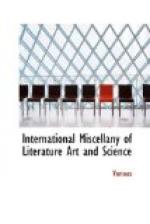Long may the good Sir Simon live and labor to realize these views. But already in a green corner of the pleasant churchyard of Rockville may be read this inscription on a marble headstone:—“Sacred to the memory of Jane Deg, the mother of Sir Simon Degge, Bart., of Rockville. This stone is erected in honor of the best of Mothers by the most grateful of sons.”
* * * * *
[From Fraser’s Magazine.]
THE SPOTTED BOWER-BIRD.
FROM LEAVES FROM THE NOTE-BOOK OF A NATURALIST.
Elegant and ingenious as are the structures and collections of the satin bower-bird, the species of the allied genus Chlamydera display still greater architectural abilities, and more extensive, collective, and decorative powers.
The spotted bower-bird[A] is an inhabitant of the interior. Its probable range, in Mr. Gould’s opinion, is widely extended over the central portions of the Australian continent; but the only parts in which he observed it, or from which he procured specimens, were the districts immediately to the north of the colony of New South Wales. During his journey into the interior he saw it in tolerable abundance at Brezi, on the river Mokai, to the northward of the Liverpool plains; and it was also equally numerous in all the low scrubby ranges in the neighborhood of the Namoi, as well as in the open brushes that intersect the plains on its borders. Mr. Gould is gifted with the eye of an observer; but from the extreme shyness of its disposition, it generally escapes the attention of ordinary travelers, and it seldom allows itself to be approached near enough for the spectator to discern its colors. Its ‘harsh, grating, scolding note,’ betrays its haunts to the intruder; but, when disturbed, it seeks the tops of the highest trees, and, generally, flies off to another locality.
[Footnote A: Chlamydera maculala.—GOULD.]
Mr. Gould obtained his specimens most readily by watching at the water-holes where they come to drink; and on one occasion, near the termination of a long drought, he was guided by a native to a deep basin in a rock where water, the produce of many antecedent months, still remained. Numbers of the spotted bower-birds, honeysuckers, and parrots, sought this welcome reservoir, which had seldom, if ever before, reflected a white face. Mr. Gould’s presence was regarded with suspicion by the winged frequenters of this attractive spot; but while he remained lying on the ground perfectly




